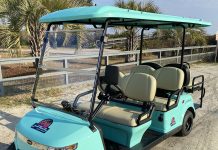
Golf Carts have come a long way
For many decades the natural habitat of the golf cart was almost any climate from the equator to the arctic circle so long as the terrain was mostly grassy, rolling hills with a few meandering paths that wandered from one relatively flat space to another usually in groupings of nine or eighteen. The relatively flat spaces had very short grass and usually featured a flag with a number on it. These were called greens that were part of an extensive system of fairways and tee boxes, ponds and sand traps … your basic golf course. You get the idea.
But the golf cart, like many other invasive species, had no natural predator to worry about and thus began a sure-footed expansion into residential communities, backcountry areas, farms, beaches, you name it.
As such, while the golf cart was perfectly adapted for the game of golf, the species had to adapt to fit other types of terrain and other expectations. New tires were a help and now, with growing popularity, those low-slung golf carts that were intentionally light and bouncy are suddenly getting taller and heavier, making them better suited to bumping over rough terrain without bottoming out while also taking on passengers in the back seat(s) which likely make them heavier than a couple of golf bags.
While companies are churning out these new species of golf carts, owners of the low, slow golf caddies who want to expand their parameters are turning to lift kits to bring their older jalopies up to speed.
Golf Cart owners are turning to lift kits
There are many reasons to buy a lift kit including the fact that they turn a buggy-looking golf cart into something that looks more like a roadster. Just the tires alone give extra height to the cart, but the fancy, new tires create another problem, which is that they shrink the clearance between the tire and the wheel well, causing them to bottom out with a heavy load or rub themselves raw against the underside of the cart.
That means you have to overhaul the underside of the cart to allow for extra height and width of the new tires and this becomes a fairly involved project that requires the help of a service station if you haven’t the tools or the know-how to get it done.
The other difficulty is a bit less obvious, which is that once you have torn apart the axle assemblies and the leaf springs, owners often figure they may as well replace every component in the cart’s carriage from ball joints to brakes. After all, you are getting a pretty sound overhaul of the suspension system, so why stop there?
DEALER LOCATOR: Find a Golf Cart Dealer Near You
One reason to stop is money, of course. A lift kit without new tires can run from $100 to $400, but it is not wise to go cheap on such a project. You don’t want taller and weaker. You want a solid job if you do this at all.
This doesn’t include labor, so you can toss in four or more hours labor charges on top of the $400 and the new tires. You can see where this gets prohibitive, because you still have those brakes, ball joints and other items you might want replaced.
While you’re at it, you’ll certainly want heavy-duty leaf springs, so you’ll have to add them in there if they don’t come with the kit. And why go this far without replacing the shocks?
After all those warning shots, while this project is extensive, it isn’t as if you are overhauling an engine. These are big, easy to reach, easy to see parts. You’ll need jacks, the right sockets, a ball joint splitter, some mechanical know-how and a few other standard tool-box items. And you might want to review a how-to video on YouTube. After that, what’s to stop you?
What’s involved in assembling a lift kit?
The basic lift kit involves removing the front axle and rack and pinion assemblies and replacing the spring plate with an extended version that is essentially like putting a spring plate with brackets in place. Then, when you put things back together, you will need spacers in various places to make up for the new reach. It’s hard to imagine anyone going this route without changing leaf springs to a heavier variety. If you want taller, but are not expecting to add any more load weight, you could get away with leaving the original leaf springs in place.
Work at the rear end also involves adding heavier leaf springs and removing the rear axle assembly. The core feature is the new shock mount plates that lift up the cart to allow for more space under the wheel wells.
Depending on the tire-expectations at the local golf course, this is often a one-way conversion, which is to say you can lift a golf cart and turn it into a back-road vehicle that also works well as a four or six-passenger carryall, but you might be canceling out the carts use on golf courses, as many of them don’t like the big, beefy tires that can chew up the luscious fairways.








I have a ezgo with a lift kit. It has 10in rims. Can I go back to stock rims or 8 in rims?
We are a group of volunteers and opening a new scheme in our community.
Your web site provided us with valuable information to work
on. You have done an impressive job and our entire community will
be grateful to you.
my web page War Robots cheats proof
Hi, all the time i used to check webpage posts here early in the morning, since
i like to find out more and more.
Take a look at my web site; Episode cheats gems